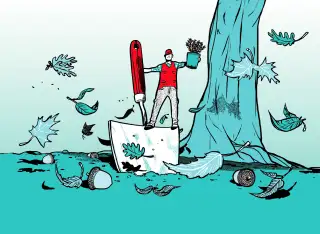4 Fall Gardening Tips That Will Save You Money All Year Long

Though spring gets all the garden-center glory, fall is a far better time to invest in your landscape. Doing the work now can save you a bundle in upfront costs—and it will continue to pay dividends all year. Not only do autumn plantings require less water and fertilizer, they also will have that much more time to get established before the withering heat of summer, which in warm climates can easily kill new plants. "But even where summers are milder, fall planting is lower cost and lower risk," says Barbara Pierson, nursery manager at garden catalogue company White Flower Farm. Here's what to do:
Pick Up Plants For Less
Many nurseries put their stock on sale in the fall to avoid storing it over the winter. You can save 40% to 50% off the price of plants, grass seed, even tools. "Don't worry if plants have a few brown leaves," Pierson says. "Remove them from their pots and make sure the roots are vibrant and not mushy."
Better yet, skip the nursery and get your plants for free. Fall is the best time to "divide" spring-flowering perennials, such as day-lilies and peonies. You can literally cut a piece, roots and all, off your favorite specimens from the yards of friends and neighbors (with permission, of course) and pick a spot for them in your yard. This process is beneficial to the original plant, and something colorful that would otherwise set you back $10 to $20 or more costs absolutely nothing. (See burpee.com for instructions.)
Just make sure to get everything in the ground at least six weeks before your average first ground-freeze date; ask at a local nursery.
Grow a Healthier Lawn
"Weed seeds don't germinate in the fall, so you get a grace period now to get a new lawn started without competition," says Wilmette, Ill., landscape architect Steve Kooyenga. Fall's typically cooler and rainier weather is on your side for turf that will be thick and strong enough to outcompete most weeds in spring. Wait to seed until then, on the other hand, and you'll probably have to repeat the treatment, at $50 to $100 a pop.
Fertilize Beds
Feeding your garden now could halve the amount of money and time you'll spend fertilizing and watering over the next year. That's because even as air temperatures drop, the ground remains warm, encouraging plants to focus their energy on root growth, says Scott Daigre of Power-plant Garden Design, in Ojai, Calif. And healthy roots mean more robust, more drought-resistant plants. Use a fertilizer with high levels of root-growth-promoting potassium (about $50 for a quarter- to half-acre lawn; a local nursery will know the right formula for your area).
Save On Spring Blooms
Fall is the only time you can plant spring-blooming bulbs such as daffodils, tulips, lilies, and hyacinths. Share a bulk order with your neighbors and you can drop the cost to about 50¢ a bulb, vs. $1 or $2. And nothing could be easier: Dig a small hole, drop in a bulb, cover with soil, and enjoy colorful flowers in the spot for years to come.